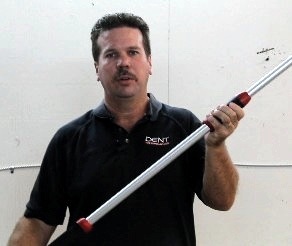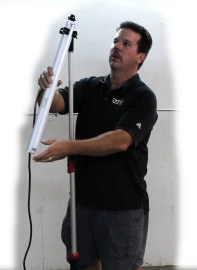Why does a paintless tech use batteries in a shop wired for electricity?
One word: CORDS!
Rolling over them is a pain and costs you time and aggravation.
Another tech is moving a car in behind yours. He parked his wheels right on your cord.
Use 12 volt batteries on your lights, your glue cart and even on your tool cart, and you’re free to move about the shop unimpeded. Speed is key and not fiddling around with cords makes you even quicker.

What batteries work best?
If you travel at all with them (and you will), the sealed gel cell type work best. Just ask Drew Lechtenberg of DruzToolz.com. He was using the wet cell kind and carried all his tools, clothes and even motorcycle in a large, enclosed trailer. When he arrived at our shop to help us with a hail storm, some of the batteries turned over and spilled acid everywhere. At the time, Drew would rather buy new stuff than do laundry, and his trailer was filled full of clothes on hangers. Clothes and battery acid do not mix.
Fortunately, their are plenty of choices in the sealed lead acid battery field. This by way of the electric wheelchair industry.
Three things will drive your battery choices. Weight, size and capacity. They are all tied together, so lets focus on capacity.
Batteries are measured in amp hours and its just like it sounds. A 33 amp hour battery can drive an item that draws 1 amp for 33 hours. Your mileage may vary, for a number of reasons. Battery age, the device type (i.e. motors draw differently than lights), and how crucial it is to stay at or near 12 volts.
The last reason noted there might not seem so important to you except for one thing. It directly affects your battery’s life.
One of the leading makers of battery testing devices in the world happens to be located here in Tulsa. I was talking with Andy McKay of Maccor one day, and I asked him what’s the best way to make these batteries last longer?
“Don’t run them down past 90% of their given voltage.”
For 12 volts this means keep it at 10.8 volts or higher.
Andy also told me, “Sealed Lead Acid batteries are not like the Ni-cads in yesterday’s cell phones. Running them down to nothing does not help. They have no memory effect. If you use it, charge it back up the same day.”
I was glad to learn this, as I’ve had some batteries last 3 years and some only 1. You can really tell when a battery starts to die. It just won’t last long as it used to.
For me, the 33Ah batts are sufficient and get me through a long day of pushing. I drop them onto a charger at night and good to go next day. I use one like this: U1-36NE Sealed Lead Acid Battery 12V 35AH with Nut and Bolt Terminal
I do know some guys who get by on much smaller batteries.
One breakthrough in paintless repair of late is the introduction of LED lights. These are very efficient and use less power than a fluorescent bulb.
LED’s use direct current right off the battery, while the fluorescent require an inverter to change the current to AC. The inverters waste a lot of power through heat due to constant switching.
For example, the current draw of an old fluorescent paintless dent light I measured was 1.2 amps. This light was 3 feet long and had a single bulb.
By comparison, my LED light with two 3 foot strips turned on showed a current load of only half that or .6 amps. So, the battery should last twice as long.
The charger technology has come a long way and will also help batteries live longer.
Deep cycle is what you want, but low amps are needed for sealed batteries, since they don’t vent.
I use a three bank charger made for a boat: MinnKota MK 315D On-Board Battery Charger (3 Banks, 5 Amps per Bank)
Had to add alligator clips to the ends, but I’m pretty handy with a solder gun. If you aren’t this version has clips already: Minnkota MK 110P 10 Amp Portable Battery Charger
This is a good beginning for the 12 volt paintless dent repair tech who wants to get fast and go cordless.
Haven’t touched on dimmers and glue guns yet, but will in a future post.
Would love to hear about your 12 volt setup. Leave a comment below.





